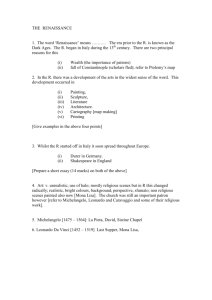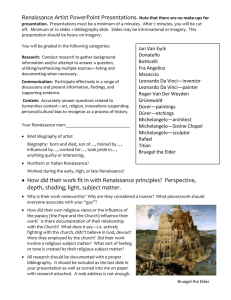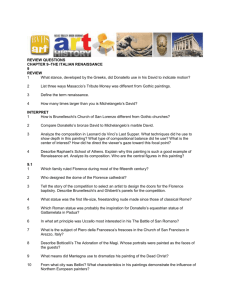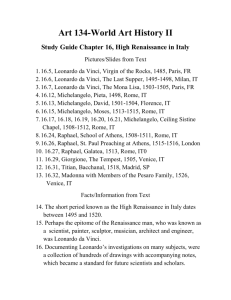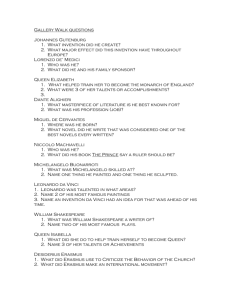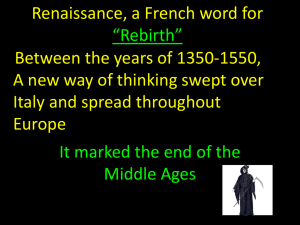Renaissance Art
advertisement
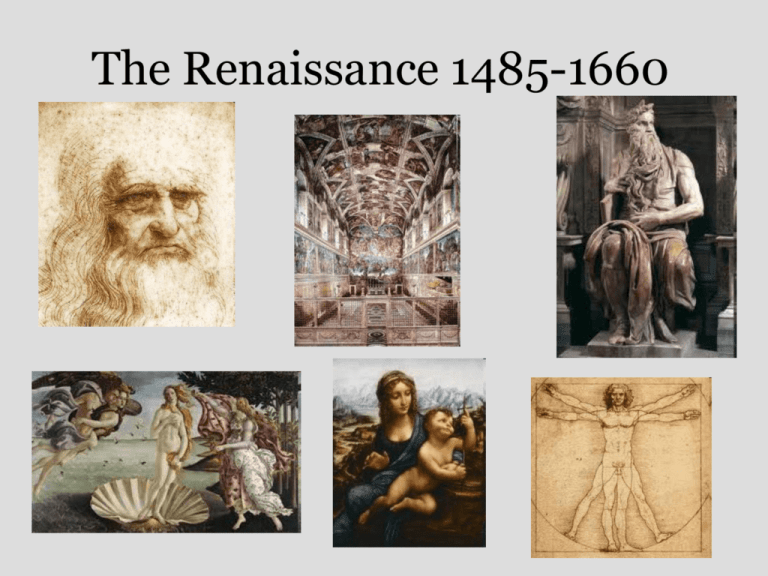
The Renaissance 1485-1660 Rediscovering Ancient Greece and Rome • • • • Renaissance is a French word which means “rebirth” Scholars renewed their interests in classical literature from ancient Greece and Rome. Most church services and documents were written in Latin so few people could read or understand this language. The term “Renaissance Man (Person)” described someone who studied/was familiar with science, art, literature, history, music, and other subjects. Today we would use the term “well-rounded.” It All Began in Italy • • • • The Renaissance period began in Italy in the 14th century and lasted until the 16th century. This period not only had a renewal of the classic literature, but people used observation to learn more about their world. Art, music, medicine, anatomy, inventions…were also a source of inspiration and knowledge. Leonardo da Vinci, Michelangelo, Christopher Columbus, and Galileo were famous men who emerged from this period. Leonardo da Vinci • • • • • Leonardo is considered by many as the father of modern science. He was one of the most acclaimed artists of the Renaissance (a period when the arts and sciences flourished). He was born on April 15, 1452 in the small town of Vinci, in Tuscany (Toscana), near Florence (Italy). Leonardo was an architect, musician, engineer, scientist and inventor. He wrote most of his notes using mirror writing. Some believe that this was to keep his ideas secret. • • • • • Leonardo sketched the first parachute, first helicopter, first aeroplane, first tank, first repeating rifle, swinging bridge, paddleboat and the first motorcar. Leonardo was very much interested in the possibility of human flight. He produced many studies of the flight of birds and plans for several flying machines. He was also a sculptor, designer of costumes, mathematician and botanist. He made maps of Europe. He invented the scissors and hydraulic pumps. Leonardo da Vinci • • • • • • • • • • Leonardo changed the way people painted and made sculptures. He established modern techniques of scientific illustration with highly accurate renderings such as ‘Embryo in the Womb’. Leonardo would wear pink to make his complexion look fresh. He never married or had children. Leonardo had a reputation of being a man of high character. He drew a self-portrait in 1515. He was undeniably one of the greatest thinkers and well ahead of his time by hundreds of years. Leonardo died on May 2, 1519 and was buried in San Fiorentino in Amboise. Da Vinci was a vegetarian. He often bought caged birds in order to release them. The novelist Matteo Bandello observed Leonardo at work and wrote that some days he would paint from dawn till dusk without stopping to eat, and then not paint for three or four days at a time The Last Supper • He painted ‘The Last Supper’ at Santa Maria delle Grazie in Milan; a dramatic depiction of the moment Jesus announced that he would be betrayed. By 1500 the painting’s deterioration had begun. Since 1726, many attempts have been made to restore it. The Mona Lisa • • • • ‘The Mona Lisa’ is perhaps his most famous work. The subject of this portrait is still debated to this day, the most popular current view being that it is of Lisa Gherardini del Giocondo. One of the most unusual hypotheses is that it is a self-portrait of Leonardo as a woman. It took him about ten years to paint Mona Lisa's lips. Da Vinci is probably most famous for his painting the Mona Lisa - now on display in the Louvre, Paris. Da Vinci was commissioned to paint the Mona Lisa, but, he never handed the painting over, and never sold it. He carried it around with him for the last 20 years of his life. Da Vinci’s other drawings • Da Vinci had a great interest in anatomy. He painted a simple sketch of the Vitruvian Man which shows the simple symmetry of man. It is also regarded as a cultural icon. • Much of Da Vinci's investigations into human anatomy were lost, as cutting up human bodies was frowned upon in that decade. Some of Da Vinci's discoveries were not made re-invented for 200 years. More drawings Michaelangelo • • • Michelangelo was born on March 6, 1475 near Arezzo, Tuscany. His birth name was Michelangelo di Lodovico Buonarroti Simoni. He was brought up in Florence. He lost his mother at an early age after which he was raised in the family of a stonecutter in the town of Settignano. Michelangelo's renown as a poet is nonetheless noteworthy. About 300 of his poetic works survive. He was also a recognized poet throughout his life. A strong contender for the title, Renaissance Man, he was also known as II Divino that means, 'the divine one'. The artists who followed his era were highly influenced by his works. Their attempts to emulate this artist gave rise to the High Renaissance movement. Michelangelo died on February 18, 1564 at the age of 88. He was the first Western artist whose biography was published while he was alive. His death meant the loss of a great artist. The Paintings on the Sistine Chapel • Michelangelo created an amazing amount of pieces of art. Two of his best and most well known works, David and Pieta, were sculpted before Michelangelo turned thirty years old. He didn't particularly like painting, but he still completed two of the most valued works in fresco that have ever been created. These works are scenes from Genesis which was on the ceiling, and The Last Judgment, which is on the altar wall in the Sistine Chapel in Rome. This took him about four years to accomplish. Originally, Michelangelo was commissioned to create the 12 Apostles in a starry sky, be he had a different idea in mind. Michelangelo wanted to have a scheme that represented creation, which was the Downfall of Man as well as the Promise of Salvation by way of the prophets and Genealogy of Christ. It originally contained more than 300 figures and had nine episodes from the Book of Genesis, which were divided into three groups. God's Creation of Humankind and their fall from the Grace of God, the state of Humanity that was represented by Noah and family, and God's Creation of the Earth. Twelve men and women who prophesisied the coming of Jesus are painted on the pendentives that support the ceiling. The Sistine Chapel Michaelangelo’s Sculpture The Statue of Davis that Michelangelo finished in 1504 was a masterpiece among the works of Renaissance. The Statue of David symbolized Florentine freedom and was made out of a marble block. His Statue of Moses, which is the most striking feature of the Pope's tomb, is surprisingly one work that was never completed to Michelangelo's satisfaction. Interestingly, Michelangelo used to spend months in selecting marble blocks for his works. Michelangelo's Pietà, a depiction of the body of Jesus on the lap of his mother Mary after the Crucifixion, was carved in 1499, when the sculptor was 24 years old. Statue of Moses The Statue of David that Michelangelo finished in 1504 was a masterpiece among the works of Renaissance. The Statue of David symbolized Florentine freedom and was made out of a marble block. His Statue of Moses, which is the most striking feature of the Pope's tomb, is surprisingly one work that was never completed to Michelangelo's satisfaction. Interestingly, Michelangelo used to spend months in selecting marble blocks for his works. Michaelangelo’s tomb Michelangelo's own tomb, at Basilica of Santa Croce, Florence Galileo • • • • • • • Galileo Galilei was born in Pisa, Italy, on the 15th of February 1564, he died on the 8th of January 1642. Galileo was a ground breaking astronomer, physicist, mathematician, philosopher and inventor. Among his inventions were telescopes, a compass and a thermometer. Galileo enrolled to do a medical degree at the University of Pisa but never finished, instead choosing to study mathematics. Galileo built on the work of others to create a telescope with around 3x magnification, he later improved on this to make telescopes with around 30x magnification. With these telescopes, Galileo was able to observe the skies in ways previously not achieved. In 1610 he made observations of 4 objects surrounding Jupiter that behaved unlike stars, these turned out to be Jupiter’s for largest satellite moons: Io, Callisto, Europa and Ganymede. They were later renamed the Galilean satellites in honor of Galileo himself. The discovery of these moons was not supported by the scientific principles of the time and Galileo had trouble convincing some people that he had indeed discovered such objects. This was similar to other ideas put forward by Galileo that were very controversial at the time. The Geocentric model of the universe which was embraced by earlier astronomers had the Earth at the center of the universe with other objects moving around it. Work by Galileo, Nicolaus Copernicus and Johannes Kepler helped to supercede this theory with the more accurate heliocentric model. Such a view of the universe differed strongly with the beliefs of the Catholic Church at the time and Galileo was forced to withdraw many of his ideas and even spent the final years of his life under house arrest. Galileo Thermometer • A Galileo thermometer (or Galilean thermometer) is a thermometer made of a sealed glass cylinder containing a clear liquid and several glass vessels of varying densities. As temperature changes, the individual floats rise or fall proportion to their respective density. • It is named after Galileo Galilei because he discovered the principle on which this thermometer is based—that the density of a liquid changes in proportion to its temperature—and invented a thermoscope based on this principle. Humanism • • • • • Tried to discover answers to the questions, “What is a good life?” “What is a human being?” Humanists did not find any conflicts between the teachings of the Church and the teachings of the ancient Greeks and Romans. Two famous humanists were Desiderius Erasmus and Thomas More. Erasmus was a Dutch monk who traveled More was a lawyer, writer, and poet. His famous book was Utopia New Technology: Printing Press • A German named Johannes Gutenberg invented the movable type printing press in 1455. • Books were handwritten by monks which took months or years so they were expensive • Gutenberg printed the complete Bible among other books which allowed easier and cheaper access to learning The Reformation • • • • The Protestant Reformation took place in many countries, but started with a monk named Martin Luther in Germany Luther proposed that people form their own relationship with God rather than a go through a Catholic priest. Many believed that the Church had too much power which caused corruption. The Protestant Reformation occurred in England when Henry VIII converted the country to the Protestant faith from the Roman Catholic faith in order to have a male heir to the thrown.
